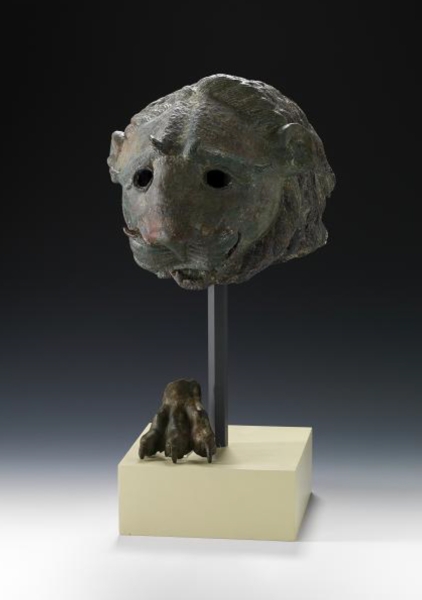
The Lion’s Head and Claw is a bronze artifact consisting of a lion’s head and part of its neck, discovered in al-Okhdood Archaeological City, located in al-Qabil Village, on the southern bank of Wadi Najran, in the south part of Najran Province, in the Kingdom of Saudi Arabia. The area is rich in historical artifacts.
Details of the face are visible on the lion’s head and the end of its paw. A section of the loop appears as a braided plait that wraps behind the ears and encircles the neck. At the top of the face, the eyebrows are depicted with a raised prominence between them, extending toward both sides. Below them are the recessed eye sockets, with the nose positioned in between. Beneath the nose, the fine details of the whiskers are evident. The mouth is depicted in a snarling position, and on both sides of the head, the ears are sculpted in a raised form.
A part of the lion’s paw (lion's legs) displays details of three toes, each ending in three curved claws.
Dimensions of the lion’s head and claw
Height: Thirty-two cm.
Length: Twenty-five cm.
Width: Twenty-three cm.
Dimensions of the claw:
Length: Ten cm.
Width: 9.5 cm.
Thickness: Four mm.
History of the lion’s head and claw
The lion’s head and claw date back to the period between two hundred BCE and one hundred CE.
The lion’s head and claw are registered under number 1328 and displayed at the Saudi National Museum in Riyadh. The artifact was selected as part of a diverse collection of archaeological discoveries from Saudi Arabia, showcased in the Archaeological Masterpieces Through the Ages Exhibition, which began its tour at the Louvre Museum in Paris, capital of France, in 2010. The exhibition later traveled to various countries across Europe, Asia, and America. The discovery of this artifact results from archaeological survey and excavation efforts conducted by the antiquities and museums sector in Saudi Arabia over the years, as well as discoveries made by Saudi archaeologists and scientific expeditions.
Significance of the lion’s head and claw
The lion’s head and claw were crafted using the lost-wax casting method and exhibit a high level of realism, confirming the existence of an advanced artistic workshop. The depiction of lions has long captivated artists since ancient times, as they were used as symbols of strength and protection, both in the southern Arabian kingdoms and the northern kingdoms.
Related quizzes
Related articles

